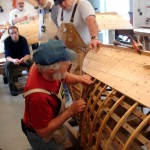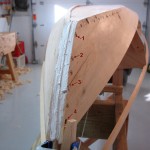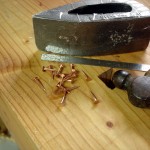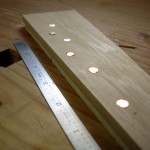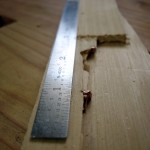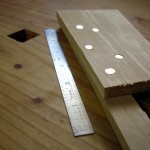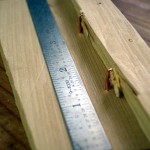My slow and deliberate boatbuilding adventure is slow not only from forgetting to order the right fasteners, but also stopping to make tools as I need them.
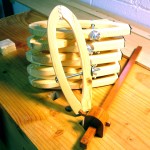 Lapstrake planking is the sort where one plank overLAPS the next. Two tools useful for this kind of construction. First, one needs to mark the width of the lap on a plank edge so that yet another rolling bevel can be planed as a joint area. Some boatbuilder make simple little gauges from a notched piece of wood. That’s basically a one-time use gauge. I decided to make a good marking gauge that will last the rest of my woodworking days. It’s in the foreground of the photo. (Click any picture to see a larger version.) It is made of cherry with a couple of coats of wiping varnish as finish.
Lapstrake planking is the sort where one plank overLAPS the next. Two tools useful for this kind of construction. First, one needs to mark the width of the lap on a plank edge so that yet another rolling bevel can be planed as a joint area. Some boatbuilder make simple little gauges from a notched piece of wood. That’s basically a one-time use gauge. I decided to make a good marking gauge that will last the rest of my woodworking days. It’s in the foreground of the photo. (Click any picture to see a larger version.) It is made of cherry with a couple of coats of wiping varnish as finish.
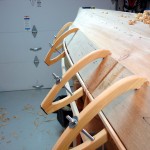 Next comes the clamps. Deep throats are needed to reach around the width of the planks, deeper than most c-clamps. These are traditional lapstrake clamps, cut from pine and poplar stock that was already on hand. The hinges are nylon belt webbing and the tip pads are rubber drawer lining material. Finish is 2 coats of boiled linseed oil thinned with mineral spirits. Yes, they are very lightweight, yet are strong enough for this lightweight planking.
Next comes the clamps. Deep throats are needed to reach around the width of the planks, deeper than most c-clamps. These are traditional lapstrake clamps, cut from pine and poplar stock that was already on hand. The hinges are nylon belt webbing and the tip pads are rubber drawer lining material. Finish is 2 coats of boiled linseed oil thinned with mineral spirits. Yes, they are very lightweight, yet are strong enough for this lightweight planking.
The wood that’s clamped to the boat is not a new plank. It is a spiling batten, 1/8 inch thick plywood. Spiling is the measurement process used to discover the shape of the next plank. Measures are taken from the lap line on the garboard plank above and from a thin temporary batten that marks the edge of the next plank.
